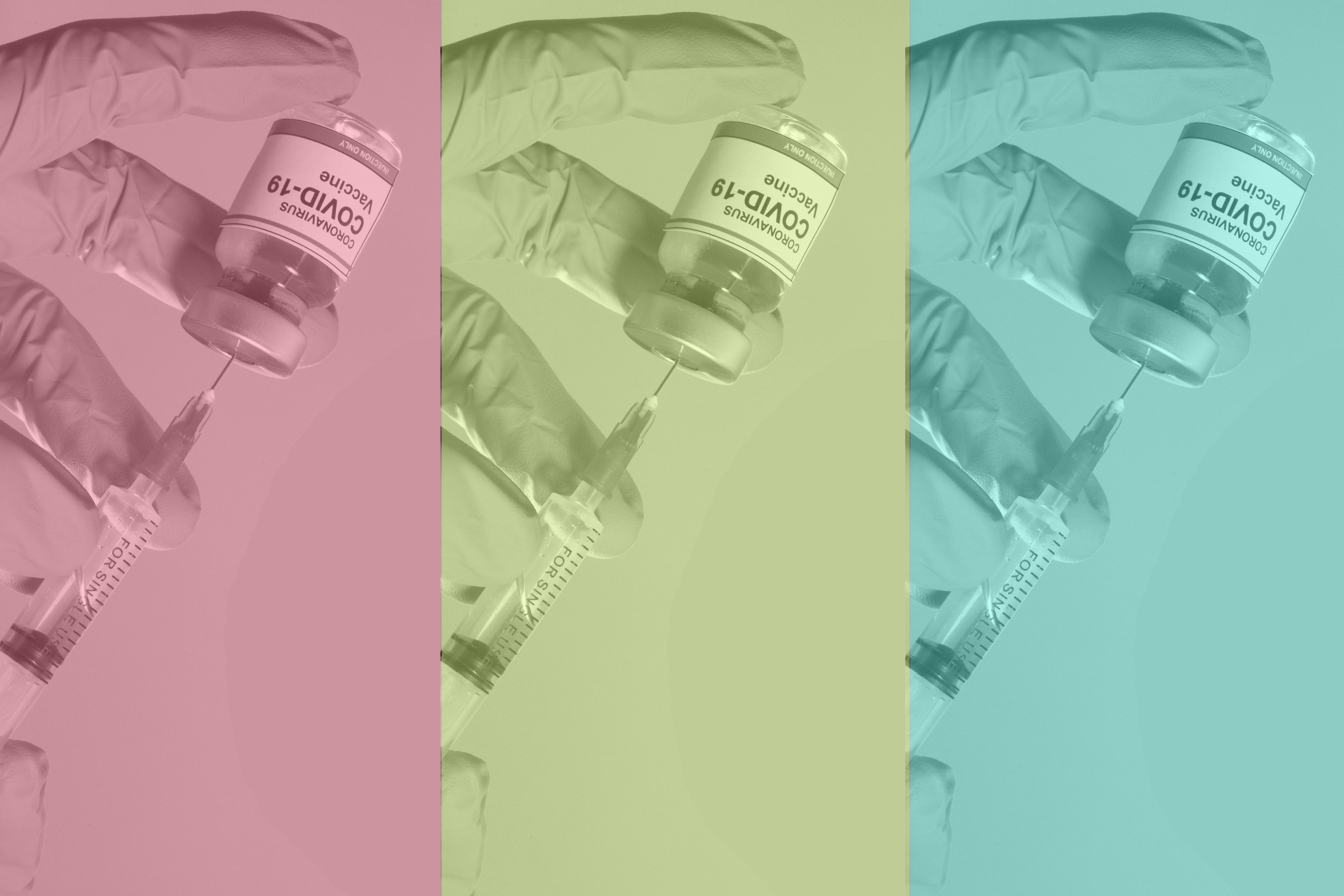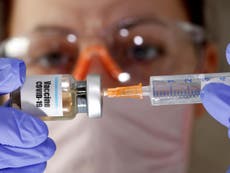‘A testament to the ingenuity of mankind’: How the world moved so quickly in developing the Covid-19 vaccines
The pandemic has opened up a new frontier for vaccinology and shown what the global scientific community is capable of when it comes together to tackle a single enemy, writes Samuel Lovett


Against all odds and expectations, the world has developed three effective vaccines to aid in the fight against Covid-19 – with more expected to follow. It marks a historic scientific achievement that many scientists feared was beyond the realms of possibility when Sars-CoV-2 first emerged late last year.
Typically, the average vaccine requires a development timeline of 10.71 years and is only 6 per cent likely to make it to market, according to research. At the start of the year, experts warned that the road to developing a vaccine was long, winding and likely to end in deflation.
Yet, after 12 months of waiting and watching, all such concerns have dissipated. The vaccine manufacturing rule book has not been ripped up in the process – far from it – but instead rewritten and improved to demonstrate what is possible when the intentional scientific community comes together with one common goal in mind.
Indeed, the pandemic has opened up a new frontier for vaccinology, proving that it doesn’t have to take 10 years or more to produce a vaccine. Thanks to the technologies behind the new Covid jabs, along with the collaborative spirt that has defined efforts to swiftly but safely test these candidates, there is now hope that humanity will be better equipped to tackle future pandemics.
So how exactly was the world able to buck the usual trends and deliver not one, but three safe and efficacious vaccines in the space of a year?
Experts who have spoken with The Independent all point to the significance of targeting the “spike” protein that coats the outside of Sars-CoV-2. This particular “antigen” – a foreign substance that triggers an immune response within the body – is what the virus uses to bind to specific receptors in our cells, allowing it to gain entry and replicate.
“That’s always an absolutely critical choice to make when designing a vaccine, to decide which bit of the pathogen is going to generate an immune response that will protect you from the infection,” Dr Brian Ferguson, professor of immunology at University of Cambridge, tells The Independent.
He explains that with some pathogens this process is “incredibly complicated”. In the case of malaria, it’s been “very difficult to choose which protein or antigen is the right one, and that’s partly why there have been many issues” in developing a vaccine for the disease, adds Dr Ferguson. The same goes for HIV, which mutates rapidly and evades the immune system’s antibodies.
But with Sars-CoV-2, scientists already had a good idea of which antigen to focus on thanks to past experiences with Sars and Mers – two other members of the coronavirus family. Vaccine research into those two viruses demonstrated the effectiveness in targeting their equivalent spike proteins, providing vaccinologists with the necessary foundations for Covid-19.
“There was an obvious choice of the antigen to try and that’s proven to be successful,” says Dr Ferguson. “It’s a case of building on previous knowledge, along with I guess a bit of luck at the same time that it happens to work in the same way.”
Although the vaccines currently in development make use of different types of technology – ranging from the messenger RNA platforms used by Moderna and Pfizer to the adenoviral vectors utilised by Oxford University – the vast majority have all opted to utilise the Sars-CoV-2 spike protein in the pursuit of inducing immunity.
“One of the main reasons these vaccines are seeming to be successful is the choice of the antigen,” says Dr Ferguson.
While this crucial detail may provide the building blocks for our Covid jabs, the introduction of new technology into the mix has proved as instrumental in ensuring the rapid production of safe, efficacious vaccines.
Messenger RNA platforms have been used to design a number of promising candidates, including the Moderna and Pfizer-BioNTech vaccines – both of which have been shown to be around 95 per cent effective.
These vaccines contain part of the genetic code of Sars-Cov-2, which trains the immune system to recognise the virus and fight it off in the future. This information molecule, the mRNA, instructs the body’s cells to produce the pathogen’s spike protein.
These cells are then identified as “foreign” by the immune system, which starts producing the necessary antibodies and T-cells to neutralise the supposed threat. This process leaves behind a protective memory that enables the body to tackle the real virus.
The technology has never made it to market before, though scientists have been exploring its application in cancer treatments for years. “It has been in development for over two decades and it has been used alongside other scientific advances to enable the production of a Covid-19 vaccine candidate in record time,” says Dr Zoltan Kis, a research associate at Imperial College London’s Future Vaccine Manufacturing Hub.
More recently, a Nature paper published in August showed that an RNA vaccine was capable of teaching the immune system in patients with advanced melanoma to tackle cancerous cells.
Once again, prior research meant that the groundwork was in place to adopt and adapt the mRNA platform against Sars-Cov-2. Scientists knew already that the technology was easy to tweak, lent itself to quick manufacturing and was not as labour intensive or complicated to produce as more conventional methods.
“With the old methods, you take the virus and deactivate it, so it still looks like the virus but isn’t harmful,” says Dr Ohid Yaqub, a senior lecturer in the Science Policy Research Unit at the University of Sussex. “It’s a fine balance to strike as you don’t want to overcook it but still need it to look like the real thing so it will elicit an immune response in the body.”
This process demands vast, financially-draining resources: entire factories, lengthy production lines specific to the vaccine, fermentation tanks, technology to sterilise the virus. More significantly, it demands time. “It’s an altogether slower way of making the vaccine,” Dr Yaqub tells The Independent.
In contrast, mRNA vaccines do away with such fuss. Once the genome for the virus is cracked – a moment that came way back in January – scientists were able to start moving “really quickly,” Dr Yaqub explains. The Moderna vaccine was designed on 13 January, way back at the beginning of the pandemic, and took just two days to develop.
“You can get the sequence [for the virus], you can figure out how exactly how to code for the antigen and get the body to make it for you,” Dr Yaqub adds. "You don’t need to make the antigen.”
It’s because of this last detail that scientists have come to see our bodies as the vaccine factory itself. Once we’ve been injected with the RNA, our cells and immune system take over to ensure immunity is generated.
“It had been a dream to be able to use this technology for a long time in response to an epidemic,” says Dr Yaqub. “That usage for mRNA wasn’t unseen. It was hoped for, but the opportunity never arose.”
This raises a similarly crucial point that must be taken into consideration when understanding why the world has developed, tested and approved a handful of vaccines in the space of 10 months. Ironically, the emergence of a jab has been just as dependent on the progress of science as the progression of the pandemic itself.
Not since the Spanish influenza has a disease as deadly as Covid-19 been so prevalent in the global population. Incidence rates have soared and soared, with few parts of the world left untouched by the virus. Millions upon millions of people have been infected: healthcare workers, politicians, bus drivers, celebrities, colleagues, friends, family members. Although the disease has disproportionately affected certain groups, it has not discriminated against those it infects, spreading far and wide.
Because of this, pharmaceutical companies like Moderna, Pfizer and AstraZeneca have been able to launch vast clinical trials – enrolling thousands of participants – to determine the efficacy of their vaccines within communities.
“You need somewhere to conduct your trial where there is high transmission rates and infections going on in the background,” Dr Gillies O’Bryan-Tear, chair of the Faculty of Pharmaceutical Medicine, tells The Independent. “Without that, you won't know if the vaccine works as it’ll take ages for it to show up [among volunteers].”
Those nations that have struggled to contain Covid-19 as a result of poor public health policies and non-compliant populations have provided fertile grounds for testing the vaccines. Among others, the US, UK and Brazil were identified as key countries in which to trial the Covid jabs and ensure the rapid advancement of large-scale phase three studies.
“In a place where there’s loads of infections going on, the benefits of the vaccine will show up very quickly,” adds Dr O’Bryan-Tear. “In a weird way, bad public health policy is actually really good for vaccine innovation.”
At the same time, researchers and scientists have stripped back the burdensome bureaucracy which has complicated the implementation of past clinical trials.
Dr Mark Toshner, a clinical doctor involved in running and recruiting volunteers for the Oxford trials, explains that people have become too hung up on the idea that it takes more than a decade to make a vaccine. “What happens in those 10 years: most of the time it’s a lot of nothing.”
“During the course of those 10 years I’ll be spending significant proportions of it writing grants, having grants rejected, rewriting them, resubmitting them.” This process, he said last month, “can take two to three years in itself”.
“Then when you’re actually lucky enough to get a grant, you have to go through a very extensive regulatory process that normally takes months and you have contract negotiations. They can sometimes take years.”
He said that the urgency to develop a vaccine has done away with much of these delays and accelerated the various moving parts of the testing phase. “Somebody described it as trying to get through London in rush hour. Imagine what that would be like if somebody cleared all the traffic, turned on the traffic lights from red to green and then you got a police escort all the way.”
However, Sarah Gilbert, the professor of vaccinology behind the Oxford vaccine, insists that no corners have been cut at any stage. If her candidate is eventually approved, she says, it will have gone through all the necessary checks and balances.
“We’ve been able to find ways to save time when going through all the normal processes,” she tells The Independent. “We’ve worked with the regulators and ethical committee to minimise the time it takes to get to approval, but the approval is still the full approval – it’s not missing anything.”
She points to “accelerated procedures” that have helped to cut away unnecessary waiting time. “Normally we can’t mention the trial and ask anyone to consider taking part until it’s all completely approved,” she says. “This time we were allowed to advertise the trials and contact people.”
Individuals who expressed an interest were then vetted and prepared for vaccination, which only followed once approval was secured. “So we had a cohort of people ready to vaccinate. That doesn’t normally happen.”
Regulatory bodies have similarly increased the speed at which they work. Rolling reviews were introduced to assess clinical trial data as it became available. This allowed bodies such as the Medicines and Healthcare products Regulatory Agency to put together a picture of the vaccines’ effectiveness and safety as the results came in.
Steve Bates, CEO of the UK BioIndustry Association, said the usual processes involved in getting a vaccine to market have been done “concurrently rather than sequentially”.
“By doing things at the same time – the discovery work, the manufacturing scale-up, the clinical trials done at pace, rolling reviews from the regulators, thinking about distribution and engagement with health systems – this shows there is the potential to transform these pathways,” he told The Independent last month.
Clearly, vaccine development has been fundamentally overhauled and streamlined throughout the pandemic. Due to the existential threat posed by Covid-19, which has closed down cities and countries, sent economies into freefall and killed millions, the scientific community was forced to rethink the way in which it approaches vaccinology.
Such urgency – and the spirit of global collaboration that has accompanied it – has been absent from previous global health emergencies. Other outbreaks of infectious diseases that threatened to knock the globe off its axis eventually petered out, meaning the development of vaccines was never able to build up steam.
The Ebola epidemic of 2013-16 came dangerously close to spiralling out of control after spreading beyond its epicentre in western Africa. Sierra Leone and Liberia were hit hardest, with cases later recorded in Senegal, Italy and the US. A total of 28,646 infections and 11,323 deaths were reported worldwide.
But despite initial fears of a pandemic, it never materialised. Authorities were able to contain the spread of the virus, cases slowly fell and the race to develop a vaccine lost all momentum. It wasn’t until last year that approval for an Ebola jab, called rVSV-ZEBOV, was granted – three years after the end of the outbreak.
Dr Gilbert points out that indifference from the private sector has also played a role in slowing down or completely ending past vaccine projects. If a jab is not seen as a worthwhile investment, big pharma will look elsewhere to make its money.
“When you say only one in 10 vaccines are successful, it’s not necessarily because they don’t work or because they’re not safe, it’s market failures,” says Dr Gilbert.
“There’s no funding to take it any further, it doesn’t get past phase one or the company does a phase two trial then decides it’ll be really expensive to build a manufacturing facility and it doesn’t want to do that because it has other priorities.”
On this occasion, pharmaceuticals had all the incentives they needed to take the plunge and invest. Whereas governments have traditionally kept their distance from vaccine manufacturing and testing, this time they were stood waiting in the wings, eager to finance such ventures.
Companies like AstraZeneca, Johnson and Johnson and Moderna have benefitted from billions of public money. The US and UK have notably splashed the cash in funding promising vaccine enterprises within their own borders – much to the delight of the private sector, which is helping to develop more than 240 Covid-19 jabs across the world.
“Normally governments would wait and see if the company made a working vaccine before committing to buy any,” says Dr Yaqub. “With Covid, not only did they commit to buying the vaccine, there were even actors [such as Bill Gates] that went ahead and said they’d make the factories that will make these vaccines. ‘If the vaccine doesn't make it, we’ll throw away the factory.’
“Imagine that scenario. A multimillion investment to make factories to make a vaccine you don’t even know if they’ll be useful or not. In hindsight, that was a really good move as we haven’t wasted time building these factories. They’re ready to go if the approval comes through. But this is all unusual, it’s not something that typically happens.”
It has taken a crisis of seismic proportions to truly stir the global health system into life, demonstrating its inherent potential to bring a vaccine to market within a matter of months. If the threats posed by Ebola, malaria, tuberculosis, polio and HIV were confronted with the same resources, the same political capital and the same urgency afforded to Covid-19, it’s not hard to envision a future in which these diseases no longer exist.
We can only hope that 2020 leaves behind a legacy that will come to benefit those countries and populations outside of the western gaze that, for decades, have struggled to overcome a plethora of health crises.
In many ways, the development of three vaccines in record time is the natural culmination of years of research into mRNA technology, of past experiences in tackling coronaviruses and what some experts have called “luck”. This is a moment we have been working towards, without knowing it.
At the same time, the scale of what has been achieved cannot be overstated. The scientific community – largely united as one – reacted with speed, purpose and clarity. Everything it needed to do to get these vaccines ready, it did. In rewriting the rules, there is now quiet hope that the advancements of 2020 will be here to stay, allowing vaccinology to take new and exciting steps forward.
The mRNA vaccines, in particular, could be applied against a whole host of infectious diseases and illnesses that exist, along with pathogens that have yet to emerge. The possibilities are endless, and leave humanity better positioned to fight those future pandemics that will inevitably strike.
“Everybody united and found ways to accelerate the process,” says Dr O’Bryan-Tear. “What we’ve done is truly a testament to the ingenuity of mankind.”





Join our commenting forum
Join thought-provoking conversations, follow other Independent readers and see their replies
0Comments